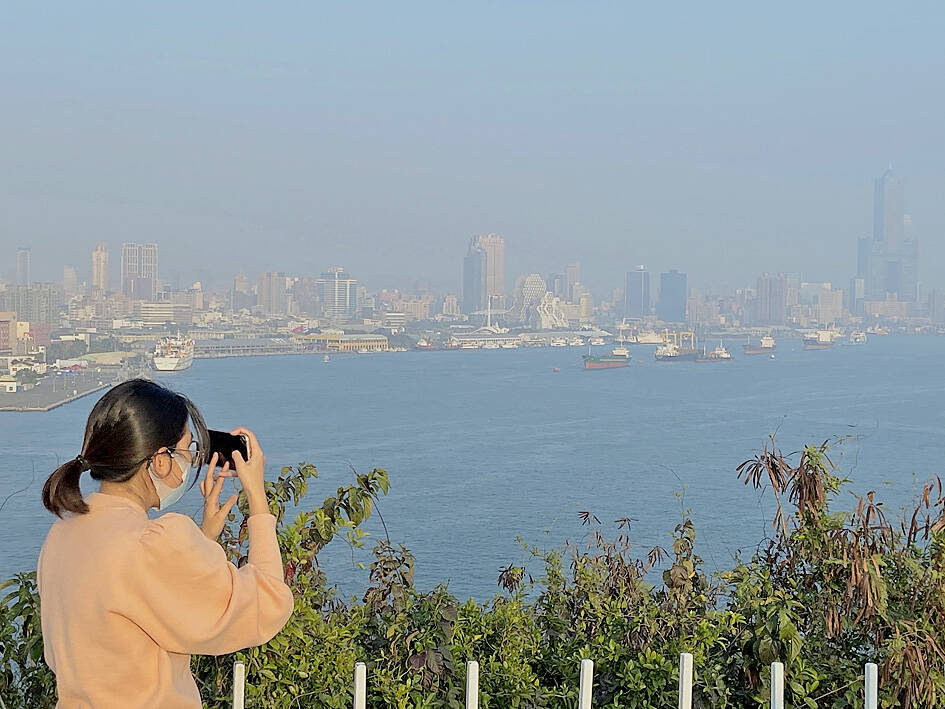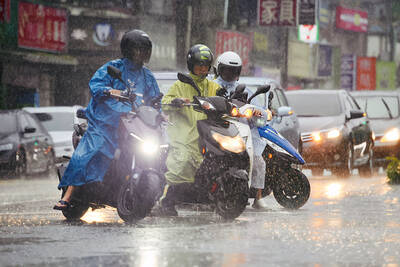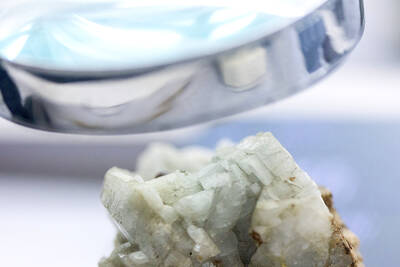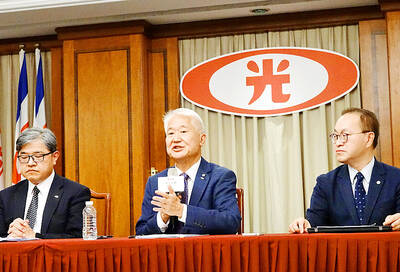Government measures to control air pollution have effectively lowered the density of main pollutants, with more than 90 percent of air quality observation stations reporting a gradual decline in the density of PM2.5 (particulate matter measuring 2.5 micrometers or smaller in diameter), PM10, nitrogen dioxide, sulfur dioxide and carbon monoxide, the National Health Research Institutes (NHRI) said yesterday.
However, only 38 percent of the observation stations showed an improvement in ozone density, associate investigator Chen Yu-cheng (陳裕政) told a news conference to present the results of the institutes’ 10-year study.
Moreover, three stations even reported a gradual increase, he added.

Photo: CNA
The density of PM2.5 fell from 31.7 micrograms per cubic meter (mcg/m3) in 2007 to 21.47mcg/m3, while deaths caused by lung cancer dropped 4.26 percent, Chen said.
Deaths caused by other chronic diseases fell substantially, including 6.91 percent for chronic obstructive pulmonary diseases, 6.56 percent for ischemic heart diseases and 7.31 percent for strokes.
A comparison of the health status of elderly people exposed to an environment with PM2.5 density of 25mcg/m3 with that of 32mcg/m3 showed that their grip strength and muscle mass decreased by 1.7 percent and 1.3 percent respectively, while their body fat increased by 2.4 percent, Chen said.
Based on the study, Taiwan would obtain the maximum benefit between the cost of economic development and the cost of improving public health if it could reduce PM2.5 concentrations to 12.5mcg/m3 — at which point both factors would be equal, Chen said.
If Taiwan hopes to reach the green sustainable development goal set by the UN, in which age-standardized attributable mortality rate caused by PM2.5 should be less than or equal to 18 per 100,000 people, the density should be further reduced to an annual average of 12.1mcg/m3, he said.
The Ministry of Environment on April 29 said that it would revise air quality standards after the results of the NHRI study are released.
The new standard for PM2.5 would be set at 12mcg/m3 after taking into account standards set in other countries, the ministry said.
Meanwhile, the air quality indicator would be revised in the second half of this year as well, it said.

The combined effect of the monsoon, the outer rim of Typhoon Fengshen and a low-pressure system is expected to bring significant rainfall this week to various parts of the nation, the Central Weather Administration (CWA) said. The heaviest rain is expected to occur today and tomorrow, with torrential rain expected in Keelung’s north coast, Yilan and the mountainous regions of Taipei and New Taipei City, the CWA said. Rivers could rise rapidly, and residents should stay away from riverbanks and avoid going to the mountains or engaging in water activities, it said. Scattered showers are expected today in central and

COOPERATION: Taiwan is aligning closely with US strategic objectives on various matters, including China’s rare earths restrictions, the Ministry of Foreign Affairs said Taiwan could deal with China’s tightened export controls on rare earth metals by turning to “urban mining,” a researcher said yesterday. Rare earth metals, which are used in semiconductors and other electronic components, could be recovered from industrial or electronic waste to reduce reliance on imports, National Cheng Kung University Department of Resources Engineering professor Lee Cheng-han (李政翰) said. Despite their name, rare earth elements are not actually rare — their abundance in the Earth’s crust is relatively high, but they are dispersed, making extraction and refining energy-intensive and environmentally damaging, he said, adding that many countries have opted to

People can preregister to receive their NT$10,000 (US$325) cash distributed from the central government on Nov. 5 after President William Lai (賴清德) yesterday signed the Special Budget for Strengthening Economic, Social and National Security Resilience, the Executive Yuan told a news conference last night. The special budget, passed by the Legislative Yuan on Friday last week with a cash handout budget of NT$236 billion, was officially submitted to the Executive Yuan and the Presidential Office yesterday afternoon. People can register through the official Web site at https://10000.gov.tw to have the funds deposited into their bank accounts, withdraw the funds at automated teller

CONCESSION: A Shin Kong official said that the firm was ‘willing to contribute’ to the nation, as the move would enable Nvidia Crop to build its headquarters in Taiwan Shin Kong Life Insurance Co (新光人壽) yesterday said it would relinquish land-use rights, or known as surface rights, for two plots in Taipei’s Beitou District (北投), paving the way for Nvidia Corp to expand its office footprint in Taiwan. The insurer said it made the decision “in the interest of the nation’s greater good” and would not seek compensation from taxpayers for potential future losses, calling the move a gesture to resolve a months-long impasse among the insurer, the Taipei City Government and the US chip giant. “The decision was made on the condition that the Taipei City Government reimburses the related